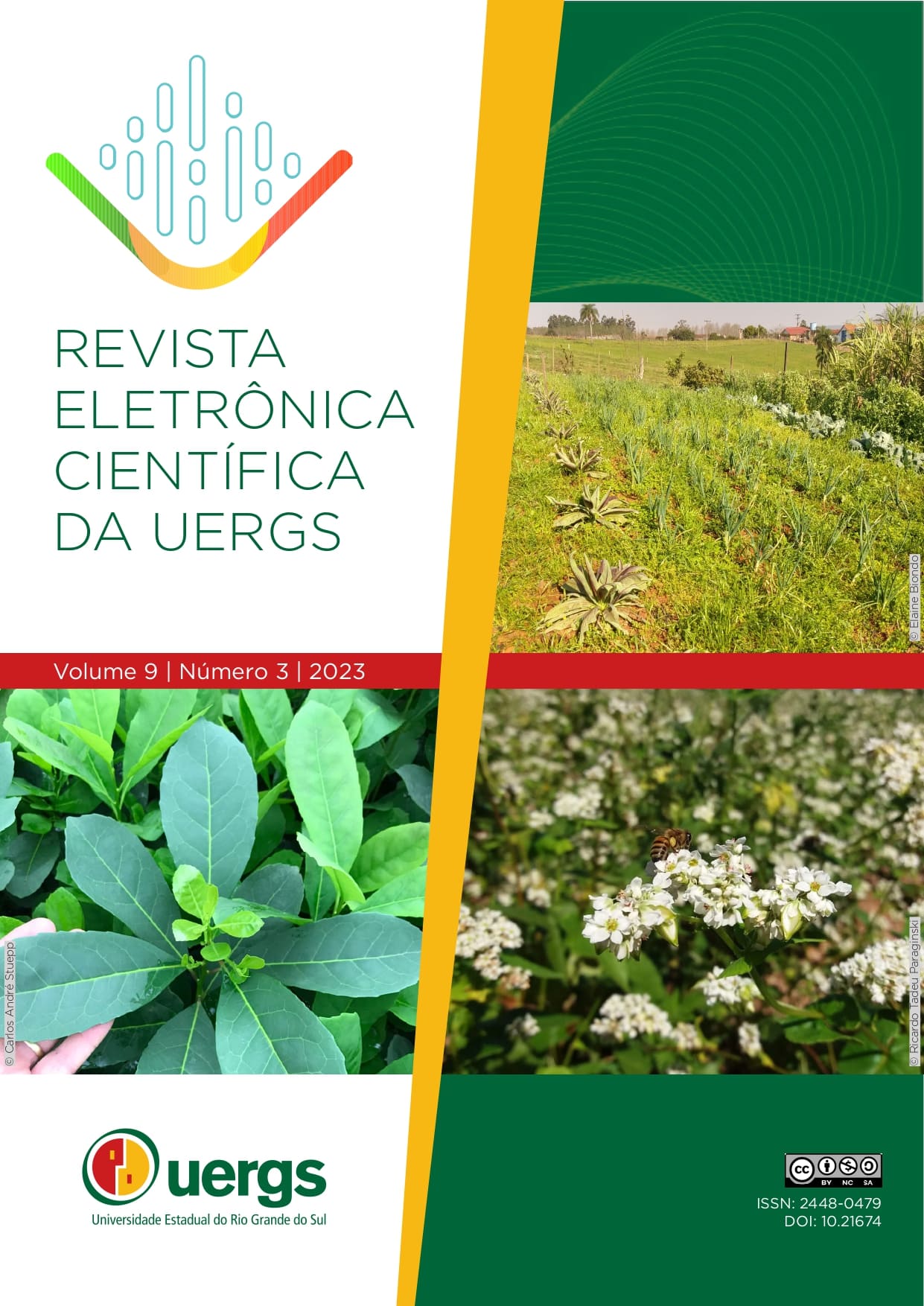Beginning of starch accumulation and root yield in registered and unregistered cassava cultivars
DOI:
https://doi.org/10.21674/2448-0479.93.178-185Keywords:
Manihot esculenta Crantz, management practice, resource use efficiency.Abstract
The beginning of starch accumulation (BSA) modifies the source/sink ratio in cassava plants, and from this stage, the tuberous roots become the main starch reserve organ in the plant. The objectives of this study were to identify the number of leaves accumulated on the main stem at the beginning of starch accumulation and to evaluate the productivity of fresh root mass in seven cassava cultivars. The experiment was conducted in the agricultural years of 2018/2019 and 2019/2020 in Santa Maria, RS, Brazil, with the registered cultivars BRS 396, BRS 399, IAC 576 and Fepagro RS13, and the unregistered cultivars in the national cultivar register Aceguá, Frita and Vassourinha. To assess the beginning of starch accumulation (root´s diameter larger than 10 mm), samples were taken weekly after the plants had gotten 15 leaves on the main stem. The yield (Mg ha-1) was determined in the eighth month after planting. The number of leaves ranged from 25 to 33 for the BSA in the tuberous roots. The morphological indicator number of accumulated leaves can be used as a non-destructive means of identifying the BSA in the field and to assist with management practices in cassava crops. The cultivars Fepagro RS13 (50,7 Mg ha-1), Vassourinha (53,5 Mg ha-1), Frita (50,4 Mg ha-1) e BRS 399 (42,9 Mg ha-1) showed the highest yields in the two agricultural years evaluated.
Downloads
References
EMBRAPA. (2015) Pesquisa desenvolve mandiocas biofortificadas nas cores creme, amarela e rosada. Disponível em: <https://www.embrapa.br/busca-de-noticias/-/noticia/6812861/pesquisa-desenvolve-mandiocas-biofortificadas-nas-cores-creme-amarela-e-rosada>. Acesso em: 22 junho, 2019.
El-Sharkawy, AM, Physiological characteristics of cassava tolerance to prolonged drought in the tropics: Implications for breeding cultivars adapted to seasonally dry and semiarid environments (2007) Plant Physiol, 19: 257-286. Doi.org/10.1007/s12892-016-0004-9
FAO - Food and Agriculture Organization of the United Nations. (2018). Food Outlook: Biannual Report on Global Food Markets. Roma: FAO. [Accessed May 10 2019]. Available at: https://reliefweb.int/sites/reliefweb.int/files/resources/CA0239EN.pdf.
Hodges TF Predict crop phenology. Boca Raton: CRC, 1991. 233p.
IBGE. Levantamento sistemático da produção agrícola. 2020. Disponível em: https://sidra.ibge.gov.br/Tabela/6588#resultado. Acesso em: 1 de julho de 2020.
Kuinchtner A, Buriol GL (2001) Clima do estado do Rio Grande do Sul segundo a classificação climáticas de köppen e Thornthwaite. Ciências Exatas 2 (1): 171-182. doi.org/10.5902/1980509835337
Matos FS, Felicio R, da Silva L M, Nascente AC de S, Custódio J PC, Guimarães RR, Santos PG de F, da Silveira, PS (2016). Produtividade de cultivares de mandioca sob déficit hídrico. Agri-environmental sciences, 2(1): 15-24. Recuperado de https://revista.unitins.br/index.php/agri-environmental-sciences/article/view/186.
Matthews RB, Hunt LA (1994) GUMCAS: a model describing the growth of cassava (Manihot esculenta L. Crantz). Field Crops Research, Amsterdam, 36: 69-84. Doi.org/10.1016/0378-4290(94)90054-X
Neto AG, Souza JM, Bonomo R, Campanharo A, Nascimento, AL (2020) Crescimento da parte aérea e produção de mandicoca para mesa sob lâminas de irrigação. AGRARIAN, 13 (50): 504-512. Doi.org/10.1590/S1413-70542010000300008
Neto NN, Bonomo R, Souza JM, Nascimento AL, Magalhães AMP (2020) Produtividade e qualidade de mandioca para mesa em diferentes épocas de colheita e lâminas de irrigação. Botucatu 24 (4):704-718. Doi.org/10.15809/irriga.2019v24n4p704-718
Schons A, Streck NA, Kraulich B, Pinheiro DG, Zanon, A J (2007). Emissão de folhas e início de acumulação de amido em raízes de uma variedade de mandioca em função da época de plantio. Ciência Rural 37: 1586-1592. doi.org/10.1590/S0103-84782007000600013
Streck VE, Kãmpf N, Dalmolin RSD, Klamt E, Nascimento PC, Giasson E, Pinto LFS Solos do Rio Grande do Sul (2018) 3° ed.
Tagliapietra BL, Zanon AJ, Silva MN, Alves AF, Freitas CPO, Tironi LF, Jiménez MSE, Cardoso PS, Santos ATL, Tonel G, Rodrigues LB, Richards NSPS, Streck NA (2019). Mandioca para alimentação humana e animal. Santa Maria: Editora Gráfica Palloti: 1-97
Tironi LF, Alves AF, Zanon AJ, Freitas CPO, Santos ATL, Cardoso PS, Tonel GP, Rodrigues LB, Tagliapietra BL, Silva MN,Streck NA. (2019). Ecofisiologia da mandioca visando altas produtividades. Santa Maria: Editora Gráfica Palloti: 1-136.
Wilhelm WW, McMaster GS. Importance of the phyllochron in studying development and growth in grasses (1995) Crop Science, Madison 35(1): 1-3. doi.org/10.2135/cropsci1995.0011183X003500010001x
Downloads
Published
How to Cite
Issue
Section
License
A reprodução total dos artigos da Revista em outros meios de comunicação eletrônicos de uso livre é permitida de acordo com a licença Creative Commons Atribuição-NãoComercial-CompartilhaIgual 4.0 Internacional.

